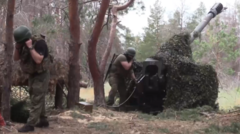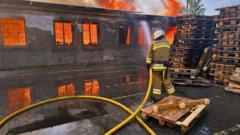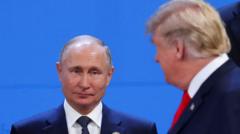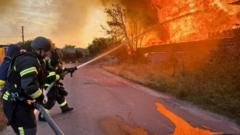More than just drone and missile assaults, Russia's ground operations in Ukraine are facing significant pushback. Recent territorial claims highlight the ongoing struggle, with both sides experiencing heavy casualties and strategic stalemates as the conflict drags on.
Russia's Frontal Assault in Ukraine: A Detailed Overview of Recent Developments

Russia's Frontal Assault in Ukraine: A Detailed Overview of Recent Developments
As Russian forces ramp up their offensive in Ukraine, the military strategy unfolds across multiple fronts while resistance remains fierce from Ukrainian troops.
Russia has intensified its military operations in Ukraine, attempting to gain control over multiple fronts, but the fierce resistance from Ukrainian forces is thwarting their advances. With record levels of drone and missile strikes, the Russian military claims to have made territorial gains with the capture of 556 square kilometers (215 square miles) last month, the largest land acquisition reported this year by DeepState monitoring.
The primary objective of Russia's current strategy is to sever supply routes that the Ukrainian troops rely on, aiming to establish a buffer zone within Ukrainian territory. However, the pace of advancement remains markedly slow, making it evident that at the current rate, complete control over Ukraine would take decades. The principal focus of Russian military operations is concentrated in three critical areas: the northeastern Sumy region bordering Russia, the eastern cities of Pokrovsk and Kostyantynivka, and a newly established front west of Pokrovsk.
In the Sumy region, Russian forces have penetrated approximately 10-12 kilometers (6-7.5 miles), yet their progress has stalled amid intense Ukrainian resistance. President Vladimir Putin's strategy appears to aim at securing a buffer to safeguard Russian territory after prior losses in the Kursk territory, though such territorial ventures have often ended up mired in conflicts over small villages that oscillate in control.
Military analysts suggest that Russia's strategy might be aimed at compelling Ukraine to distribute its forces more thinly across the expansive 1,200-kilometer frontline. This challenge is particularly apparent in Pokrovsk, which has remained a strategic target for over two years. Ukrainian Army General Oleksandr Syrskyi notes that Russian forces have amassed around 111,000 troops in the region, yet significant troop movements are swiftly detected and countered by Ukrainian drones.
Russian forces are employing a "creeping offensive" method, utilizing smaller groups of infantry to persistently attack Ukrainian positions. Reports indicate this tactic is an attempt to wear down Ukrainian defenses, with some estimates stating that Russia is sustaining casualties of over 1,000 soldiers daily. Ukraine's military efforts aim to maintain control over key areas while managing increasingly complex supply chain challenges, exacerbated by drone strikes that disrupt logistics and operations.
One area showing notable Russian advancement is the Novopavlivske direction, where military observers reveal that advancements have occurred due to perceived weaknesses in Ukrainian defenses. However, this approach's implications are politically driven rather than strategically sound, with advancing into Dnipropetrovsk region generating more propaganda leverage than tactical advantage.
Despite attempts to bolster their positions, the overall momentum appears to be waning for Russian forces as logistical challenges mount. Ukraine's military, now relying on robotic systems for supply delivery to frontline troops, is also grappling with increased threats of drone strikes targeting both operational and civilian areas, highlighting the grim realities of the conflict. The dual strategy of military engagement and psychological warfare carried out by Russian forces continues to challenge the resilience of the Ukrainian people as the situation develops.






















